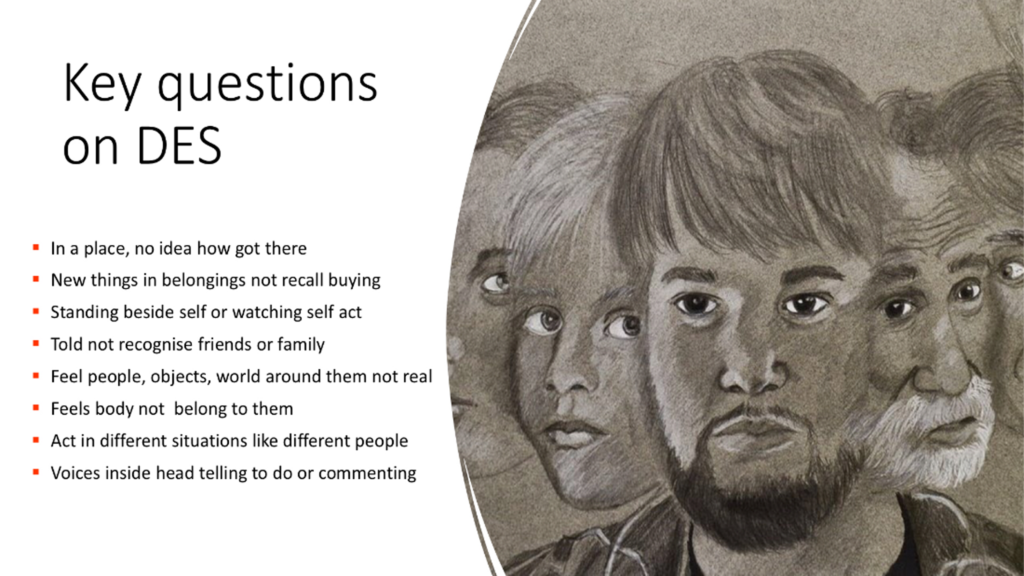Essential skills for working with challenging ego states in the preparation/stabilisation and early processing phases of EMDR therapy: review of the clinical workshop

The workshop presented by Dr Michael Patterson OBE & Dr Bridget O’Rawe MB Bch BAO, started with an introduction to the different theoretical models of structural dissociation. Within the different models, various terms have been used over the years, to describe parts – alters, ego states, internal family systems and modes (to name just a few). Michael told an amusing tale of his own attendance at various workshops in the past, including with Jeffrey Young (explaining his schema therapy model), and how he came to understand the subject area for himself. For him it seemed that terms such as parts, alters and ego states refer to similar, or analogous phenomena and can therefore be used interchangeably. This felt like an open and honest opinion; and given the tribalism that often exists between theoretical orientations within psychotherapy, it was refreshing to hear. The main models referred to in the workshop were, Steele, Nijenhuis, and Van der Hart (2001) ‘Structural Dissociation Model’ and Watkins and Watkins (1997) ‘Differentiation-Disassociation Continuum’.
This topic is important for the EMDR therapist because without this knowledge there is the potential risk of unintentionally activating the dissociated parts of a client during a processing session. At best this could result in blocked processing or ‘looping’; or at worst, having a harmful effect on the client’s well-being, or the therapeutic relationship. Clues to the presence of other parts might come from a deeper exploration of responses to questions on the Dissociative Experiences Scale – II (DES-II) during the history taking phase. See figure 1. When working with these complex people the EMDR therapist needs to be competent and confident with working with different parts, to have a sense of the client’s internal system and to ensure safe stabilisation and an appropriate level of resourcing.

Michael said that the ‘job of the therapist’ when working with people with challenging ego states is to create “stabilisation for them, so that they can be grounded enough to work on the trauma that created these states in the first place”. Bridget emphasised the need for therapeutic rapport, repeated psychoeducation, and the development of a shared space or ‘homebase’, alongside an explanation of polyvagal theory and exercises. The homebase consists of a conference area where all the parts can meet, a healing space, where they can go if they are troubled, individual safe/calm places and individual containers. Bridget showed a video of herself using EMD during a session with a client in the homebase. She skilfully found out which parts were present and helped them to feel safe in the homebase. She described the use of various polyvagal exercises such as the polyvagal flame. This exercise involved the client illustrating and aligning known parts of their system with the three main polyvagal branches (ventral-vagal, sympathetic, and dorsal vagal). This enabled the client to not only view their parts as an integrated whole, but to see the potential for movement and change within the system. I will try this out with some of my own clients, as this may contribute to gently providing further adaptive information as a resource.
Bridget emphasised the need for firm boundaries, e.g., the duration of therapy sessions, when holidays will be taken, and the amount of contact that is permitted between sessions. This is very containing for these clients.
Structural dissociation models
The structural dissociation model (Steele et al., 2001) distinguishes between primary, secondary, and tertiary forms of dissociation. Primary structural dissociation can best be described as ‘one foot in the present and one foot in the past’. Symptoms such as nightmares flashbacks and intrusions are present. There is an overlap between the apparently normal personality (ANP) and emotional personality (EP). From an evolutionary perspective the ANP, consists of action systems which are considered as the most basic elements that shape the personality as they enable the individual to function in daily life (Van der Hart, Nijenhuis & Steele, 2006).
Secondary structural dissociation is more associated with symptoms of depersonalisation and derealisation. There is one ANP and more than one emotional personality. The EPs seemingly dividing according to the function of submit, fight or flight.
Tertiary structural dissociation refers to parts being separated through amnesic barriers. There may possibly be more than one version of the ANP and more than one version of the EP, with the increased potential for state-dependent memory. This means that memory recall, is determined by the ‘host’s’ present physical or emotional state, being the same in which the encoding of the memory first took place.
Different emotional personalities overlap with different versions of apparently normal personality, some having shared memory networks, whilst others do not. Different states may or may not be aware of other parts of the personality. For example, some ANP and EPs appear to overlap, suggesting some level of shared awareness or knowledge of each other. Some of the parts might be minimally dissociated from each other, whereas other parts are completely segregated or unaware of the rest of the system.
The concept of an ANP has implications for what is called, in schema therapy, the ‘healthy adult mode’ (Young, Klosko & Weishaar, 2003). For example, how many times during a schema therapy session might a client present as being in the ‘healthy adult mode’, and unbeknownst to both therapist and client, may be experiencing a variant of the ANP?
In order to function, the ‘structurally dissociated’ individual has had to compartmentalise their existence, consequently they will have apparently normal personalities for day-to-day function and survival of the species. However, because of this, many of these parts will also fight for their own survival. This is not to suggest that the aim is to eliminate a client’s ego state, rather it is about integrating the parts in to a more functional and adaptive sense of self. As Bridget reminded us, this doesn’t necessarily mean the integration of all parts, as some may wish to remain separate to the rest of the system, as they are “happy to live together as A,B,C and share information”.
Watkins and Watkins (1997), conceptualise dissociated parts and ego states through various states of severity on a continuum. Michael explained this continuum, by describing the role of adaptive amnesic barriers. In everyday life the non-traumatised individual needs to access different parts of themselves, for the different roles their life demands of them, in any given moment of the ‘natural attitude’ of life (Luft, 1998). For instance, the role of therapist, the role of parent, the role of lover etc. On some level, these various roles need to be interconnected to give a sense of the whole self (Van der Hart et al., 2006). These natural sequences of identity help to make life’s activities flow so that the individual can function smoothly. In contrast to this, with structural dissociation, where the action subsystems of the individual have been separated or divorced from their daily life activities, the dissociated individual may act in a manner that does not seem appropriate to the context or the present activity they are actively engaged in.
I find Watkins and Watkins (1997) ego state model one of the most comprehensive and easy to understand. I particularly liked how Michael used the floor of the conference room, to illustrate the state shifts of the parts and how the continuum states may not be aware of each other. Michael used the physical space to illustrate the client’s experience both in the healthy, everyday flow of life and further down the continuum of dissociation.
The ordering of the workshop material introduced the structural dissociation model of Nijenhuis et al. (2001), followed by the differentiation dissociation continuum Watkins and Watkins (1997). This helped to cement the message that different states may not have access to the same memory networks, and why this can impact on an individual’s current sense of temporal and spatial awareness.
Finally, Bridget emphasised the need for the therapist to keep themselves focused and on task by asking themselves the following questions during the history taking phase:
- Where is the patient on the continuum?
- How can I access the different parts?
- What are the parts and what roles do they play?
- How can I develop an internal dialogue with the parts to facilitate trauma processing?
Summary
The standard protocol was used throughout but with a slight adaptation during Phase I. The presenters referred to the use of an ‘inverted protocol’, where the phases go back and forth between history taking and resourcing. This is done to prevent overwhelming the patient, reducing the potential for further dissociation. Psychoeducation is repeated again and again because of the possibility of dissociative amnesia.
This was for me, an important workshop, which provided a practical and clinical grounding for both experienced and newly qualified EMDR therapists. Michael and Bridget’s warm, compassionate, and unpretentious interpersonal style made an often complex and confusing subject area feel far more accessible and understandable. A real take home for me was that compassion, collaboration and respect is needed for all parts of the system, whatever their role.
Bridget and Michael worked well together in their presentation, and I could have happily watched them both talking about this subject for longer than time allowed. They included an impressive amount of content and I fear I have not been able to do justice to all of it. I would certainly urge the interested reader to access the recording if possible. Many useful links including essential resources and further reading can be found at Michael’s website, http://www.emdrmasterclass.com .
References
Forgash, C., & Copeley, M. (2008) Healing the heart of trauma and dissociation with EMDR and ego state therapy. New York: Springer Publishing Co.
Luft, S. (1998). Husserl’s phenomenological discovery of the natural attitude. Continental Philosophy Review, 31, 153-170.
Patterson, M., & O’Rawe, B. (2023) Essential skills for working with challenging ego states in the preparation/stabilisation and early processing phases of EMDR therapy. Conference presentation at the EMDR UK 2023 Annual Conference & AGM, Glasgow.
Porges, S. W. (2009). The polyvagal theory: New insights into adaptive reactions of the autonomic nervous system. Cleveland Clinic Journal of Medicine, 76 (Suppl 2), S86.
Steele, K., van der Hart, O., & Nijenhuis, E. R. (2001). Dependency in the treatment of complex posttraumatic stress disorder and dissociative disorders. Journal of Trauma & Dissociation, 2(4), 79-116.
Van der Hart, O., Nijenhuis, E. R. S., & Steele, K. (2006). The haunted self: Structural dissociation and the treatment of chronic traumatization. New York: Norton.
Van der Kolk, B. (2014). The body keeps the score: Brain, mind, and body in the healing of trauma. New York: Penguin.
Watkins, J. G., & Watkins, H. H. (1997). Ego states: Theory and therapy. New York: Norton.
Young, J. E., Klosko, J. S., & Weishaar, M. E. (2003). Schema Therapy: A practitioner’s guide. New York: Guildford Press.



